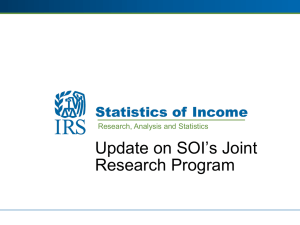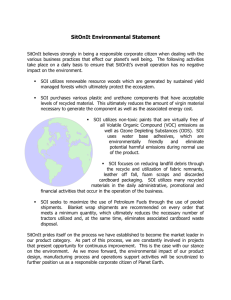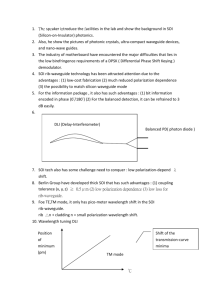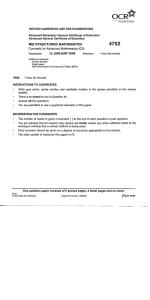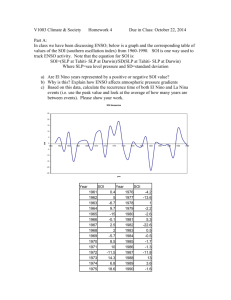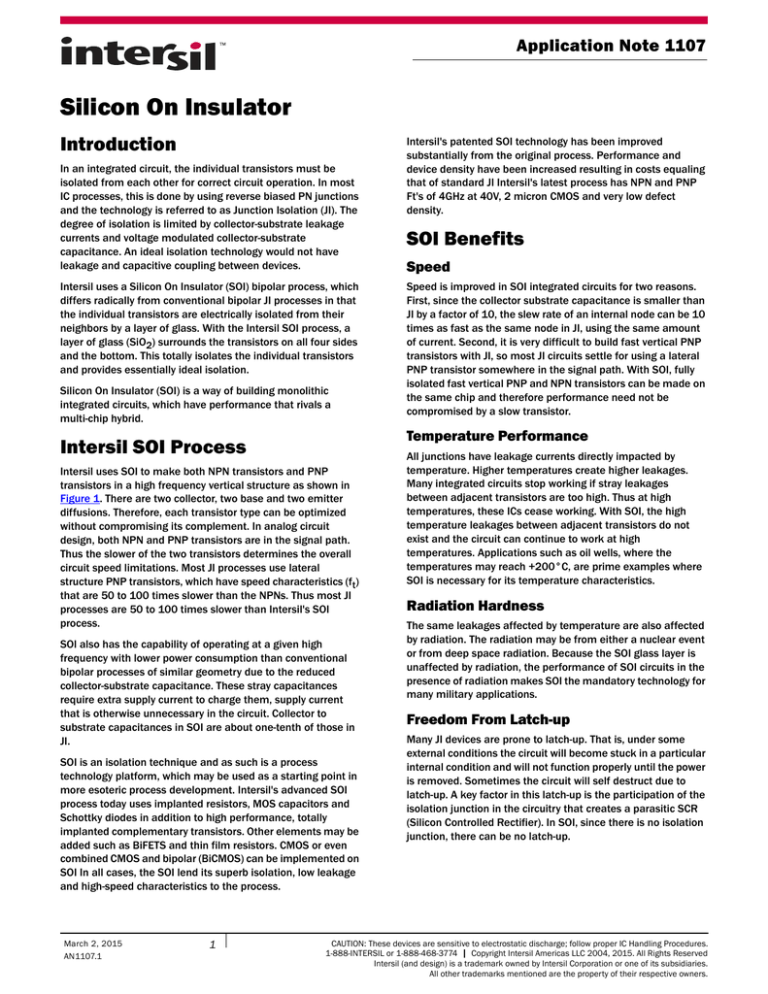
Application Note 1107
Silicon On Insulator
Introduction
In an integrated circuit, the individual transistors must be
isolated from each other for correct circuit operation. In most
IC processes, this is done by using reverse biased PN junctions
and the technology is referred to as Junction Isolation (JI). The
degree of isolation is limited by collector-substrate leakage
currents and voltage modulated collector-substrate
capacitance. An ideal isolation technology would not have
leakage and capacitive coupling between devices.
Intersil uses a Silicon On Insulator (SOI) bipolar process, which
differs radically from conventional bipolar JI processes in that
the individual transistors are electrically isolated from their
neighbors by a layer of glass. With the Intersil SOI process, a
layer of glass (SiO2) surrounds the transistors on all four sides
and the bottom. This totally isolates the individual transistors
and provides essentially ideal isolation.
Silicon On Insulator (SOI) is a way of building monolithic
integrated circuits, which have performance that rivals a
multi-chip hybrid.
Intersil uses SOI to make both NPN transistors and PNP
transistors in a high frequency vertical structure as shown in
Figure 1. There are two collector, two base and two emitter
diffusions. Therefore, each transistor type can be optimized
without compromising its complement. In analog circuit
design, both NPN and PNP transistors are in the signal path.
Thus the slower of the two transistors determines the overall
circuit speed limitations. Most JI processes use lateral
structure PNP transistors, which have speed characteristics (ft)
that are 50 to 100 times slower than the NPNs. Thus most JI
processes are 50 to 100 times slower than Intersil's SOI
process.
SOI also has the capability of operating at a given high
frequency with lower power consumption than conventional
bipolar processes of similar geometry due to the reduced
collector-substrate capacitance. These stray capacitances
require extra supply current to charge them, supply current
that is otherwise unnecessary in the circuit. Collector to
substrate capacitances in SOI are about one-tenth of those in
JI.
SOI is an isolation technique and as such is a process
technology platform, which may be used as a starting point in
more esoteric process development. Intersil's advanced SOI
process today uses implanted resistors, MOS capacitors and
Schottky diodes in addition to high performance, totally
implanted complementary transistors. Other elements may be
added such as BiFETS and thin film resistors. CMOS or even
combined CMOS and bipolar (BiCMOS) can be implemented on
SOI In all cases, the SOI lend its superb isolation, low leakage
and high-speed characteristics to the process.
1
SOI Benefits
Speed
Speed is improved in SOI integrated circuits for two reasons.
First, since the collector substrate capacitance is smaller than
JI by a factor of 10, the slew rate of an internal node can be 10
times as fast as the same node in JI, using the same amount
of current. Second, it is very difficult to build fast vertical PNP
transistors with JI, so most JI circuits settle for using a lateral
PNP transistor somewhere in the signal path. With SOI, fully
isolated fast vertical PNP and NPN transistors can be made on
the same chip and therefore performance need not be
compromised by a slow transistor.
Temperature Performance
Intersil SOI Process
March 2, 2015
AN1107.1
Intersil's patented SOI technology has been improved
substantially from the original process. Performance and
device density have been increased resulting in costs equaling
that of standard JI Intersil's latest process has NPN and PNP
Ft's of 4GHz at 40V, 2 micron CMOS and very low defect
density.
All junctions have leakage currents directly impacted by
temperature. Higher temperatures create higher leakages.
Many integrated circuits stop working if stray leakages
between adjacent transistors are too high. Thus at high
temperatures, these ICs cease working. With SOI, the high
temperature leakages between adjacent transistors do not
exist and the circuit can continue to work at high
temperatures. Applications such as oil wells, where the
temperatures may reach +200°C, are prime examples where
SOI is necessary for its temperature characteristics.
Radiation Hardness
The same leakages affected by temperature are also affected
by radiation. The radiation may be from either a nuclear event
or from deep space radiation. Because the SOI glass layer is
unaffected by radiation, the performance of SOI circuits in the
presence of radiation makes SOI the mandatory technology for
many military applications.
Freedom From Latch-up
Many JI devices are prone to latch-up. That is, under some
external conditions the circuit will become stuck in a particular
internal condition and will not function properly until the power
is removed. Sometimes the circuit will self destruct due to
latch-up. A key factor in this latch-up is the participation of the
isolation junction in the circuitry that creates a parasitic SCR
(Silicon Controlled Rectifier). In SOI, since there is no isolation
junction, there can be no latch-up.
CAUTION: These devices are sensitive to electrostatic discharge; follow proper IC Handling Procedures.
1-888-INTERSIL or 1-888-468-3774 | Copyright Intersil Americas LLC 2004, 2015. All Rights Reserved
Intersil (and design) is a trademark owned by Intersil Corporation or one of its subsidiaries.
All other trademarks mentioned are the property of their respective owners.
Application Note 1107
Intersil SOI Advantages Over JI
• Speed
- Fast (vertical) PNPs and NPNs
- Lower Collector to substrate capacitance
- Collector to substrate capacitance not modulated by
collector voltage
• No Possibility of Circuit Latch-up via Parasitic SCRs
- No parasitic devices with SOI
• Operates in High Temperature and Radiation Environments
- Leakage currents are blocked by SOI walls
• High Voltage Operation
- Device to device breakdown >2000V
• Mixed Technologies on Same Chip
- Bipolar transistors, diffused resistors and MOS can be done
on the same monolithic chip
FIGURE 1. COMPLIMENTARY SOI PROCESS
Intersil Corporation reserves the right to make changes in circuit design, software and/or specifications at any time without notice. Accordingly, the reader is
cautioned to verify that the document is current before proceeding.
For information regarding Intersil Corporation and its products, see www.intersil.com
Submit Document Feedback
2
AN1107.1
March 2, 2015

